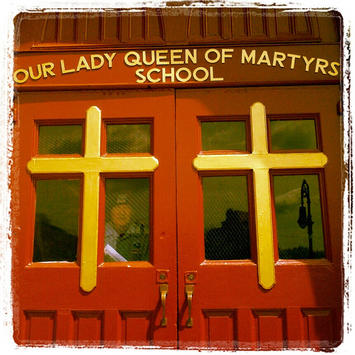
In a heart-breaking scene in the 2010 documentary Waiting for Superman, a young mother is crying in her Harlem apartment, which overlooks her daughter’s school. Bianca, her daughter, has been barred from attending graduation. The villain isn’t a union boss or a bureaucrat in Albany – instead, it's the Archdiocese of New York and its affable leader, Cardinal Dolan. Bianca hadn't misbehaved or been excessively tardy. But her mother owed the school a few hundred dollars in tuition and fees.
The Archdiocese’s schools cannot afford to be lenient with such hard-luck cases, because they are drowning in red ink, too. The solution has been to shutter uneconomical schools, even those where parents raised vast sums to keep them open. If the un-named Catholic school Bianca attended hasn't been closed already, it probably will be soon. In late January, the Archdiocese released a list of 26 schools slated for closure in June, on top of the 50 it closed in the two years previous.
Across the US, 167 Catholic schools closed in 2012, according the National Catholic Education Association, with 27 in the New York Archdiocese alone. If nothing radical is done, by this time next year parents at another two dozen Catholic schools in New York will be scrambling to find a new school for their kids.
The decline of New York’s Catholic schools has been dramatic. In 1961, the Archdiocese boasted over 414 elementary and high schools, and an enrollment of over 213,000 pupils. After the latest round of closings, the Archdiocese will have fewer than 250 schools and an enrollment of 70,000 students.
For decades, Catholic schools promised poor and urban communities rigorous academic and values-based education at a low cost. Catholic school alumni graduated high school, attended college, stayed out of jail and joined the middle class at staggering rates. Hardworking parents like Bianca’s mom recognized the value proposition of a high-quality education at a low cost.
But for many of New York’s neediest families that promise is going unfulfilled. Most parents sacrifice immensely to pay tuition, but it’s becoming prohibitively expensive. Catholic school costs are rising, as personnel costs balloon and dilapidated, century-old buildings need repairs. In the event of layoffs, teachers unions (yes, Catholic schools are closed shops in New York) insist the most senior (read: expensive) teachers be the first re-hired when an opening occurs.
Across the US, the Catholic school average annual per-pupil cost jumped from $5,600 in 1998 to $10,800 in 2010, and tuition costs for 9th graders doubled from $4,300 to $8,800 in the same period. Philanthropists have tried to make up the shortfall, but the waves of red ink keep swallowing up school budgets. Furthermore, Catholic schools are rarely transparent as to why tuition is rising twice as fast as inflation (because per-pupil costs are rising even faster).
Adding to Catholic school woes, new research by Albany Law School’s Abe Lackman suggests that competition with charter schools is partly responsible for the Catholic school enrollment decline. Although the future of charters in a post-Mayor Bloomberg New York remains unclear, the promise of charter schools – a high-quality education for no cost – has created an education marketplace where Catholic schools must compete to survive. Says John Eriksen, the former superintendent of Paterson, New Jersey’s diocese schools, “Charter schools are competition, and Catholic schools that don’t recognize that will be on the menu instead of having a seat at the table.”
Catholic schools should recognize that the rise of charters is an opportunity, not a threat. Charters borrowed Catholic schools' best practices (discipline, academic rigor, and uniforms), and now Catholic schools should return the favor and adopt the entrepreneurial and innovation-focused ethos of charter schools (you can see my report for the Lexington Institute, urging this approach, here.)
One such path is “blended learning” – an academic model that promises not only excellence but financial sustainability. At blended learning charter schools from Newark’s Merit Prep to San Jose’s Rocketship schools, instructors work in concert with online tools to deliver the right lesson to the right student at the right time. Students progress through lessons at their own pace toward subject mastery, while teachers use real-time data generated from students' online work to guide individual and small-group instruction to children's specific levels of mastery. The results have been impressive: Rocketship’s five schools are among California’s highest performing elementary schools.
On the brink of closure, a Catholic K-8 school in San Francisco, Mission Dolores Academy, adopted this innovative method. After one year, student scores jumped 16% in math and 6% in reading. By increasing class sizes and enrollment, per-pupil costs have fallen by an astounding 20% over the last two years.
Mission Dolores and its sister school in Seattle, St. Therese, were only able to innovate because their respective parishes granted the schools independence. Philadelphia’s Archbishop Charles Chaput recognized the need for independence to enact reform and ceded control of its 17 high schools to the Faith in the Future Foundation, led by longtime education reformer Casey Carter. Another 16 inner-city elementary schools joined the Independent Mission Schools consortium. Both organizations have committed to transparency, efficiency and major investments in academic excellence like blended learning.
Cardinal Dolan should follow Chaput’s lead. Excellent and efficient Catholic schools are sustainable and necessary.
Flickr photo by Joe Shlabotnik, Our Lady Queen of Martyrs School, Forest Hills, New York.
Sean Kennedy is a fellow at the Lexington Institute in Arlington, Va., and author of the recent study, Building 21st Century Catholic Learning Communities: Enhancing the Catholic Mission with Data, Blended Learning, and Other Best Practices From Top Charter Schools. Kennedy is a graduate of Catholic elementary and secondary schools.












